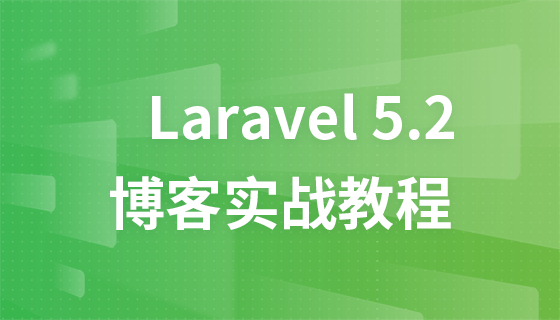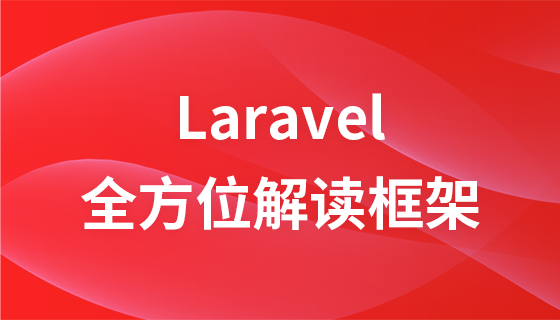本篇文章给大家带来的内容是关于laravel框架的中间件middleware的详解,有一定的参考价值,有需要的朋友可以参考一下,希望对你有所帮助。
laravel中间件是个非常方便的东西,能将一些逻辑实现解耦,并且在laravel中,
中间件的编写也是非常的方便。谁用谁知道。
1.装饰器模式
laravel中的中间件使用的就是装饰器模式,什么是[装饰器模式][1],先去了解一下吧,这里大概说一下,就是这个模式主要的就是用于解决 当一个类需要动态扩展功能的时候,使用继承的方式会让子类膨胀,并且这个扩展的功能是个公用功能的情况下,不利于功能的复用以及代码的解耦。
在laravel,使用对于使用这种模式的功能,称为请求处理管道,也就是pipeline
//公共接口
interface middleware {
public static function handle(Closure $next);
}
//装饰器1
class MiddleStepOne implements middleware{
public static function handle(Closure $next) {
echo "前期处理的第一步"."<br>";
$next();
echo "后期处理的第一步"."<br>";
}
}
//装饰器2
class MiddleStepTwo implements middleware{
public static function handle(Closure $next) {
echo "前期处理的第二步"."<br>";
$next();
echo "后期处理的第二步"."<br>";
}
}
function goFunc() {
return function ($step,$className) {
return function () use ($step,$className) {
return $className::handle($step);
};
};
}
$pip = array(
MiddleStepOne::class,
MiddleStepTwo::class,
);
$pip = array_reverse($pip); //反转数组,以求达到要求的顺序运行
$first = function (){
echo "前期处理完毕"."<br>";
}; //实际要处理的函数
$a = array_reduce($pip,goFunc(),$first); //遍历pip数组,并将first作为第一个参数传递进去
$a(); //执行输出:

这个就是一个简单的基于装饰器模式的管道。他的本质其实就是基于闭包和递归。
通过分析这个程序,对于最终生成的$a变量,它的值大概是这样的 MiddleStepOne.handle(MiddleStepTwo.handle(first)),当执行的时候因为在handle中有个next()函数的存在,所以这是一个递归的调用。对于laravel的中间件,他的实现原理也是和这个一样的。
2.laravel中的中间件和请求处理管道
在laravel中,我们我们可以通过设置中间件来在请求执行之前做一些预先的处理。
从请求入口 public/index.php开始
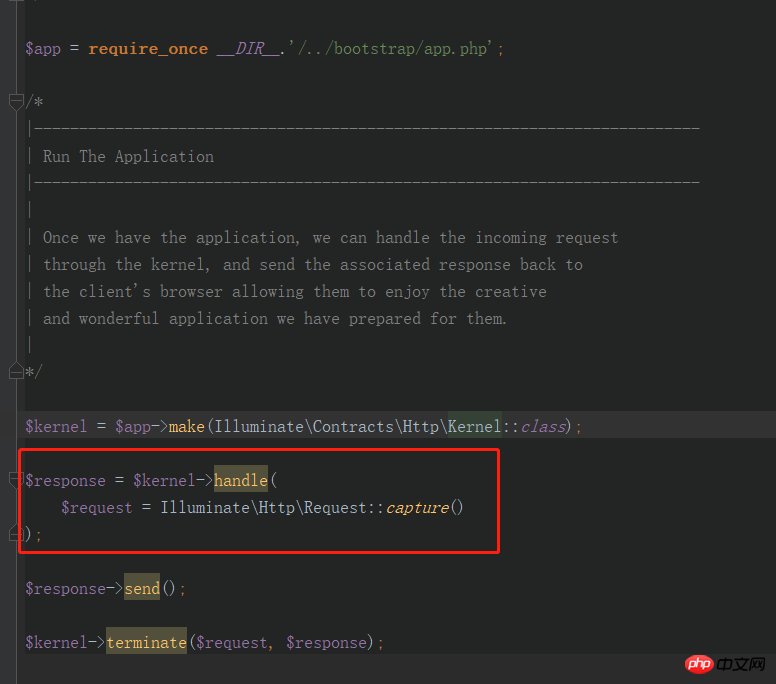
重要的是这段代码:即 处理请求,返回请求的响应
$response = $kernel->handle( $request = Illuminate\Http\Request::capture() //创建一个请求实例 );
接着我们进入kernel中看他的具体实现 IlluminateFoundationHttpKernel.php中
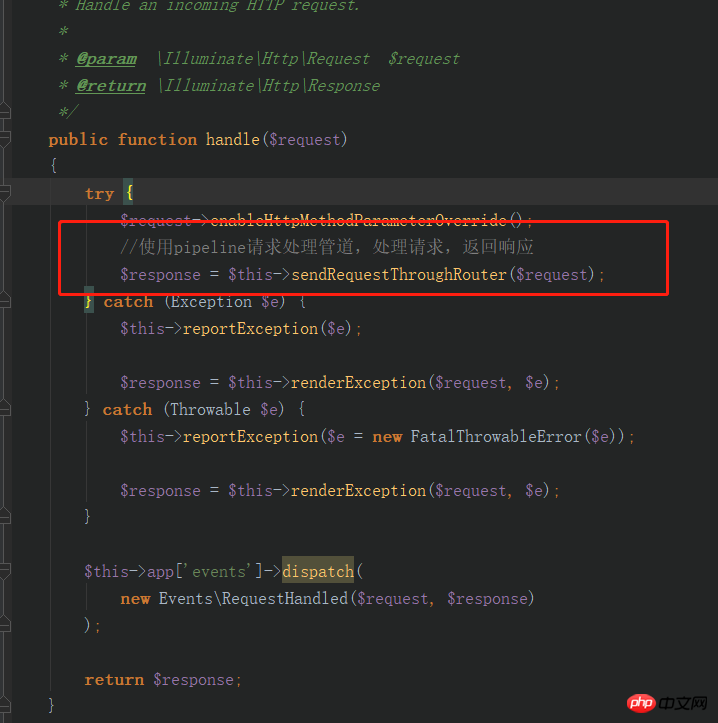
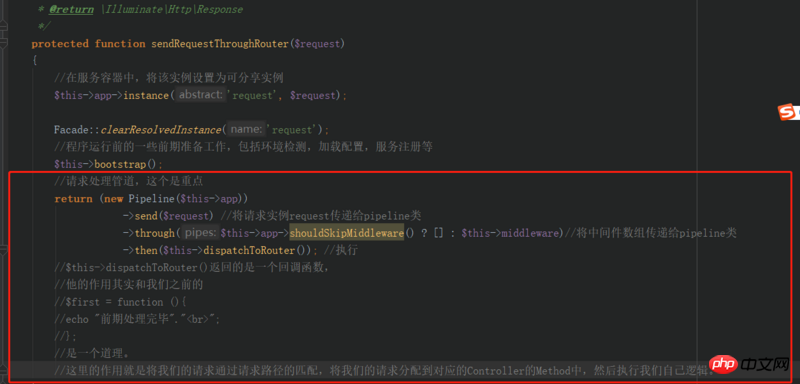
关于dispatchToRouter()函数请大家自己去看,这里就不多说了。
接下来就是激动人心的PipeLine类了,
<?php
namespace Illuminate\Pipeline;
use Closure;
use RuntimeException;
use Illuminate\Contracts\Container\Container;
use Illuminate\Contracts\Pipeline\Pipeline as PipelineContract;
class Pipeline implements PipelineContract
{
/**
* The container implementation.
*
* @var \Illuminate\Contracts\Container\Container
*/
protected $container;
/**
* The object being passed through the pipeline.
*
* @var mixed
*/
protected $passable;
/**
* The array of class pipes.
*
* @var array
*/
protected $pipes = [];
/**
* The method to call on each pipe.
*
* @var string
*/
protected $method = 'handle';
/**
* Create a new class instance.
*
* @param \Illuminate\Contracts\Container\Container|null $container
* @return void
*/
public function __construct(Container $container = null)
{
$this->container = $container;
}
/**
* Set the object being sent through the pipeline.
*
* @param mixed $passable
* @return $this
*/
public function send($passable)
{
$this->passable = $passable;
return $this;
}
/**
* Set the array of pipes.
*
* @param array|mixed $pipes
* @return $this
*/
public function through($pipes)
{
$this->pipes = is_array($pipes) ? $pipes : func_get_args();
return $this;
}
/**
* Set the method to call on the pipes.
*
* @param string $method
* @return $this
*/
public function via($method)
{
$this->method = $method;
return $this;
}
/**
* Run the pipeline with a final destination callback.
*
* @param \Closure $destination
* @return mixed
*/
public function then(Closure $destination)
{
$pipeline = array_reduce(
array_reverse($this->pipes), $this->carry(), $this->prepareDestination($destination)
);
return $pipeline($this->passable);
}
/**
* Get the final piece of the Closure onion.
*
* @param \Closure $destination
* @return \Closure
*/
protected function prepareDestination(Closure $destination)
{
return function ($passable) use ($destination) {
return $destination($passable);
};
}
/**
* Get a Closure that represents a slice of the application onion.
*
* @return \Closure
*/
protected function carry()
{
return function ($stack, $pipe) {
return function ($passable) use ($stack, $pipe) {
if (is_callable($pipe)) {
// If the pipe is an instance of a Closure, we will just call it directly but
// otherwise we'll resolve the pipes out of the container and call it with
// the appropriate method and arguments, returning the results back out.
//如果pip也就中间件函数是一个闭包可调用函数,就直接返回这个闭包函数就行了
//这里我还没有找到对应的使用场景,后续补充
return $pipe($passable, $stack);
} elseif (! is_object($pipe)) {
list($name, $parameters) = $this->parsePipeString($pipe);
// If the pipe is a string we will parse the string and resolve the class out
// of the dependency injection container. We can then build a callable and
// execute the pipe function giving in the parameters that are required.
$pipe = $this->getContainer()->make($name);
$parameters = array_merge([$passable, $stack], $parameters);
} else {
// If the pipe is already an object we'll just make a callable and pass it to
// the pipe as-is. There is no need to do any extra parsing and formatting
// since the object we're given was already a fully instantiated object.
$parameters = [$passable, $stack];
}
return method_exists($pipe, $this->method)
? $pipe->{$this->method}(...$parameters)
: $pipe(...$parameters);
};
};
}
/**
* Parse full pipe string to get name and parameters.
*
* @param string $pipe
* @return array
*/
protected function parsePipeString($pipe)
{
list($name, $parameters) = array_pad(explode(':', $pipe, 2), 2, []);
if (is_string($parameters)) {
$parameters = explode(',', $parameters);
}
return [$name, $parameters];
}
/**
* Get the container instance.
*
* @return \Illuminate\Contracts\Container\Container
* @throws \RuntimeException
*/
protected function getContainer()
{
if (! $this->container) {
throw new RuntimeException('A container instance has not been passed to the Pipeline.');
}
return $this->container;
}
}总的来说pipeLine类的实现和我之前写的修饰器是差不多,这里主要麻烦的地方就在于就在于
protected function carry()函数内部,对于当pip是闭包,字符串,还有对象的处理。
之前觉得laravel的中间件是个很神秘的东西,但是看了之后才觉得也就那样,很精巧,在实际开发中这种模式也是很有帮助的,例如我们目前用的一个gateway项目,因为没有使用任何框架,所以将判断条件剥离,写入到中间件中, 这样实现了一定程度上的模块化编程。
以上是laravel框架的中间件middleware的详解的详细内容。更多信息请关注PHP中文网其他相关文章!
